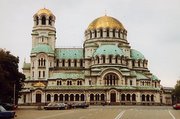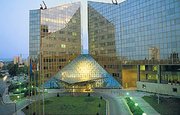Sofia
|
|
The city of Sofia (Bulgarian: София), at the foot of the Vitosha mountain, has a population of 1,208,930 (2003), and is the biggest city and capital of the Republic of Bulgaria. It is located in the Western part of Bulgaria at the foot of the mountain massif Vitosha and it is the administrative, cultural, and industrial center of the country.
| Coat of Arms | Map |
|---|---|
| Missing image Sofia_gerb.png Sofia's coat of arms | |
| Data | |
| Municipality(Oblast): | Sofia-City (София-град) |
| Area: | 1,310 km² |
| Altitude: | 550 m |
| Population: | 1,192,603 census December 15,2004 |
| Population density: | 907 persons/km² |
| Average age of population: | 38.3 years |
| Postal code: | 1000 |
| Dialing code: | 02 |
| Municipal Code: | C |
| motto of the city: | "It grows but does not age" |
| latitude: | 42° 42' N |
| longitude: | 23° 20' E |
| mayor (кмет): | (SSD) Stefan Sofiyanski |
| Missing image Sofia,_Bulgaria.JPG Satelite picture of Sofia | |
| Contents |
History
On a site inhabited as early as the 8th century B.C., Sofia is the second oldest capital city in Europe. It has been given several names in the course of history, and the remnants of the old cities can still be seen today.
Sofia was originally a Thracian settlement named Serdica, named after the Thracian tribe of Serdi. It was captured by Rome in AD 29. When Diocletian divided the province of Dacia into Dacia Ripensis on the shores of the Danube and Dacia Mediterranea, Serdica became the capital of Dacia Mediterranea. It was destroyed by the Huns in 447. The city was rebuilt by Byzantine Emperor Justinian I and renamed Triaditsa. Known as Sredets under the Bulgars, it was renamed Sofia (meaning "wisdom" in Greek) in 1376. Sofia was taken by the Ottomans in 1382 and became the capital of the Turkish province of Rumelia. Sofia was taken by the Russians in 1878, and became the capital of an independent Bulgaria in 1879. During World War II the Russians captured Sofia and Bulgaria from the pro-German government.
There are 16 universities in the city, among them Sofia University (http://www.uni-sofia.bg), founded in 1889. It is the see of an Eastern Orthodox metropolitan and of a Roman Catholic diocese. Landmarks include the Church of St. George, the Church of Saint Sofia, the Boyana Church, the Banya Bashi, and the Alexander Nevski Cathedral.
SofiaCathedral2.jpg
Economy
Sofia is a major centre in Bulgaria's economic life. The manufacturing sector of the economy, represented by over 800 large manufacturing plants, includes metal products (75% of the total output in the country), textiles, rubber and leather goods, printing (50% of output) and electronics (15% of output). Sofia is also the country's financial hub, home to the Bulgarian National Bank, the Bulgarian Stock Exchange, as well as some of the country's largest commercial banks (such Bulbank, DSK Bank (http://www.dskbank.bg/en/en_index.htm) and the United Bulgarian Bank (http://www.ubb.bg/index-en.htm)). Construction, trade and transport are other important sectors to the local economy. Increasingly Sofia is getting attention as an outsourcing location for Western European and Amrerican multinationals.
Administration
Sofia is one of 28 counties in Bulgaria. Besides the city of Sofia, the capital county encompasses three other cities and 34 villages. It is split into 24 municipalities.
Each municipality has a head person who is elected by the municipal assembly. The head of the county is its mayor (кмет). The assembly members are chosen every four years. Stefan Sofiyanski is serving his third term as of 2005. He was first elected in 1995.
Transport
With its well-developed infrastructure and strategic location, Sofia is an important centre for international railway and automobile routes. All major types of transport (except water transport) are represented in the city, which is home to 8 railway stations, the Centre for Flight Control and the Sofia Airport (hub for flag-carrier Bulgaria Air). Three Trans-European Transport Corridors cross the city: 4, 8 and 10.
Public transit is well-developed, reliable and important to the city's economy; it is provided by means of underground trains (the Sofia Metro), buses, trams and electric buses. There are over 15,000 licensed taxi cabs operating in the city.
Backpacking information
A "Guia del Ocio"-type of guide is available at Programata.bg (http://www.programata.bg/index.php?page=&ln=2&city=1).
An electronic map is available at BGMaps.com (http://www.bgmaps.com/home.asp?lang=en)
Three hostels are Art Hostel (http://www.art-hostel.com/), Hostel Mostel (http://www.hostelmostel.com/) and Kervan Hostel (http://www.kervanhostel.com/)
Night life
A vibrant city with rich and colorful night life, Sofia is known for a great number of modern discoteques, live music clubs, cozy restaurants, chic cafes and hype bars.
Notable Sofia music clubs are O'Shipka (rock, metal, hard-core) and Tri-Ushi (punk, ska, reggae) and the most vibrant bars include Barabar and Kufera both of which represent a broad cross section of Sofia's most interesting night-life.
Many Erasmus students, EU volunteers can be found at "The A-Partment" sort-of-private club.
The place to eat between clubs is Mimas - a doner kebap located at the intersection of Levski, Graf Ignatiev and Patriarch Evtimii streets.
During the summer, the place to go is Lodkite - an open-air bar in the city park. There is also a weekly drum circle in an abandoned summer stage in the same park, similar to Barcelona's Parque de la Ciutadella and Madrid's Retiro.
Sofia-skyline-360-wikipedia-edit.jpg
Key figures
Housing
- Number of units - 475,900
- Utilised area - 30 km²
- Living area per person - 15.1 m²
- Centrally-heated housing units - 437,000
- Length of the water supply network - 2,657 km
- Length of the drainage network - 822 km
- Length of the electricity network - 7,823 km
- Telephone land lines - 408,000
Street network
- Length - 2,670 km
- Area 28.126 km²
- vehicles - 750,000
Green zones
- Total number - 2,810
- Area – 54.41 km²
- Green zones per person - 48.7 m²
Institutions of higher education
- Bulgarian Academy of Sciences (http://www.bas.bg/)
- Sofia University St. Clement of Ohrid (Kliment Ohridski) (http://www.uni-sofia.bg/)
- University for National and World Economics (http://www.unwe.acad.bg/)
- University of Architecture, Construction and Geodesy (http://www.uacg.acad.bg/)
- Sofia Technical University (http://www.tu-sofia.bg/)
- University of Chemical Technology and Metallurgy (http://www.uctm.edu/)
- St. John of Rila (Ivan Rilski) University of Mining and Technology (http://www.mgu.bg/)
- Bulgarian Evangelical Theological Institute (http://www.betibg.org/)
- University of Forestry (http://www.ltu.bg/)
- Sofia Medical University (http://www.medun.acad.bg/)
- Vassil Levski National Sports Academy (http://www.nsa.bg/)
- Krastio Sarafov National Academy for the Theatre and Film Arts (http://natfiz.bitex.com/)
- National Academy for the Fine Arts (http://www.art.acad.bg/art/index-b.html)
- Prof. Pancho Vladigerov State Academy of Music (http://www.art.acad.bg/music/index-b.html)
- New Bulgarian University (http://www.nbu.bg/)
- Luben Karavelov Higher School for Civil Engineering (http://www.vsu.bg/)
- Todor Kableshkov Higher School for Transportation (http://www.vtu.bg/)
- Police Academy (http://www.vipond.mvr.bg/)
- G.S. Rakovsky Military Academy (http://rakovski-defcol.mod.bg/)
External links
- Official webpage (http://www.sofia.bg/en/index_en.asp)
- Sofia City Council (http://www.sofiacouncil.bg/)
- Sofia.com (http://www.sofia.com)
- Sofia Life Travel Guide (http://www.sofia-life.com)
- Pictures from Sofia (http://www.pbase.com/ngruev/sofia)
- More pictures from Sofia (http://www.pbase.com/ngruev/sofia2)
- Cultural Guide (http://www.programata.bg)
- Brief Information on Sofia (http://www.easybulgarian.com/tourism/sofia.html)
See also: List of cities in Bulgariabg:София ca:Sofia da:Sofia de:Sofia es:Sofía eo:Sofio fr:Sofia ko:소피야 he:סופיה id:Sofia io:Sofiya it:Sofia nl:Sofia (Bulgarije) no:Sofia mk:Софија ja:ソフィア (都市) pl:Sofia pt:Sófia ro:Sofia ru:София sr:Софија fi:Sofia sv:Sofia, Bulgarien tt:Sofia zh:索菲亞





